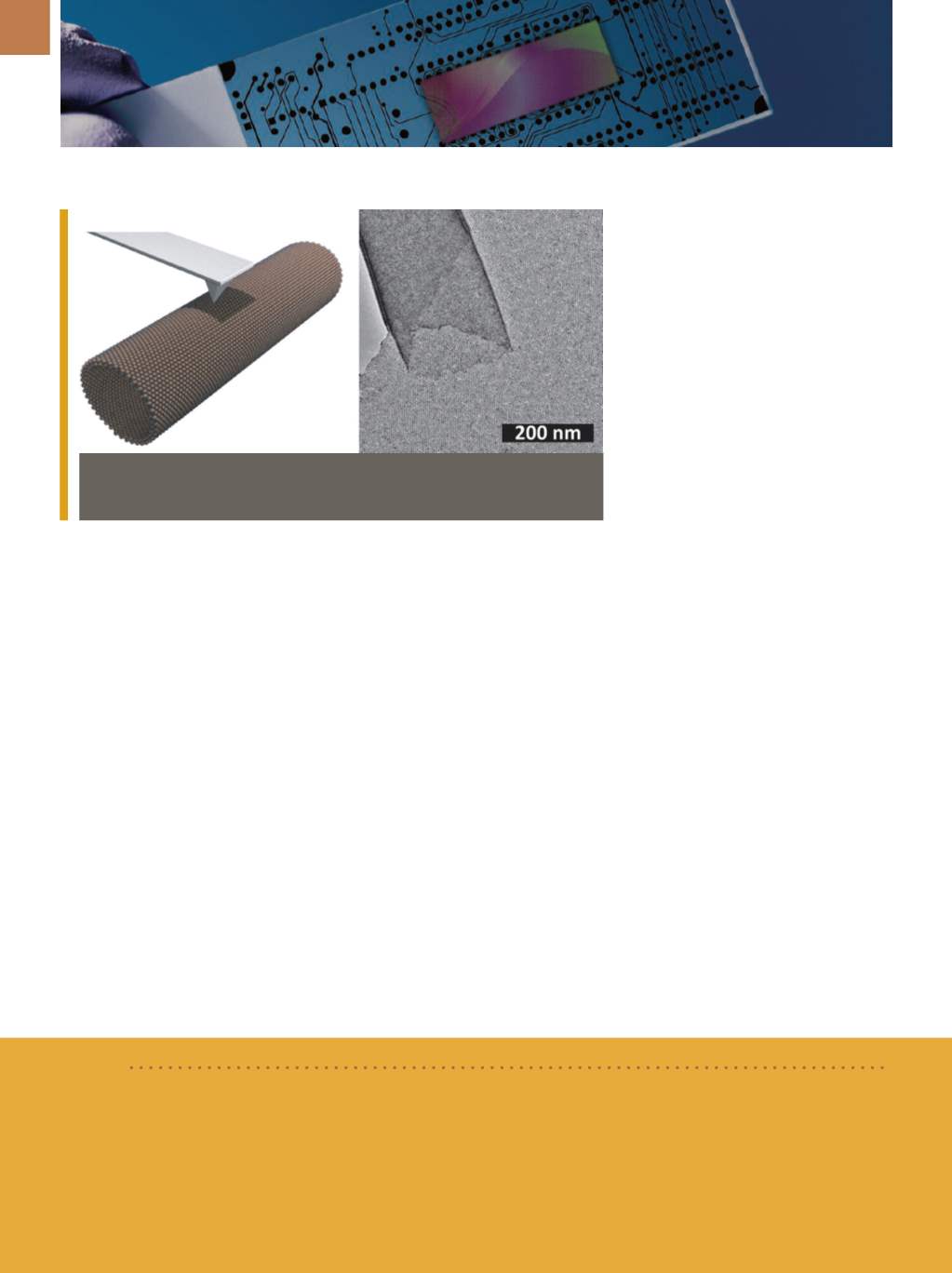

A D V A N C E D M A T E R I A L S & P R O C E S S E S | N O V E M B E R / D E C E M B E R 2 0 1 5
1 6
NANOTECHNOLOGY
GOLD NANOMEMBRANES
RESIST FLEXING
The first direct measurement of
resistance to bending in a nanoscale
membrane was made by scientists from
the University of Chicago, Peking Univer-
sity, the Weizmann Institute of Science,
and the Department of Energy’s (DOE)
Argonne National Laboratory. Their find-
ings give researchers a new and simpli-
fied method to measure nanomaterials’
resistance to bending and stretching,
opening new possibilities for creating
nanosized objects andmachines by con-
trolling and tailoring that resistance.
“Researchers around the world are
seeking ways to manipulate ultrathin
nanomaterials into stable 3D objects.
The challenge is how to make a 2D film
into a 3D shape when the film is so thin
and flexible. You need something stiffer
than you would expect. It turns out that
many nanomembranes may already
possess that property,” explains Hein-
rich Jaeger of the University of Chicago.
“We were surprised to find that
the gold nanomembrane was over 100
times more resistant to bending than
we predicted, based on standard elastic-
ity theory and our experience with thin
sheets such as paper,” says Xiao-Min Lin,
who fabricated the gold nanoparticles in
specialized facilities at the Center for Na-
noscale Materials at Argonne.
Critical to the team’s discovery is
a new method for creating gold mem-
branes that roll themselves into nano-
sized scrolls plus a new technique for
measuring the scroll’s resistance to
bending. The nanoscrolls were self-as-
sembled by suspending a fluid con-
taining gold nanoparticles on a carbon
screen. As the fluid dried, it left a gold
membrane suspended likeanano-drum-
head across the screen’s circular holes.
As the membranes continued to dry
and tighten, one edge pulled loose from
Scientists discovered how to measure the resistance of a nanomembrane to both
bending and stretching by rolling it into a tube andmeasuring the tube’s bending
resistance along its length. Courtesy of ANL.
BRIEF
The
National Science Foundation
will provide a total of $81 million over five years to support 16 sites and a coordi-
nating office as part of a new
National Nanotechnology Coordinated Infrastructure
(NNCI).The NNCI sites provide
researchers from academia, government, and industry access to university facilities with fabrication and characteri-
zation tools, instrumentation, and expertise within nanoscale science, engineering, and technology.
nsf.gov.the screen, and the membrane sponta-
neously rolled up to form a hollow tube.
Because the measurement is based only
on elasticity theory and the tube’s geom-
etry, it should have general applicability
across a wide range of materials and size
scales, from nano and microtubules to
macroscopic objects.
anl.gov.NANOSENSORS DETECT
LEAD ELECTROCHEMICALLY
Anodized aluminum oxide (AAO)
nanosensor arrays are now being used
to electrochemically detect lead levels
in a rapid and inexpensive manner, say
researchers at Zetanostics Inc., Santa
Fe, N.M. The simple electrochemical
approach uses a potentiostat and does
not require reagents, spectroscopy, or
colorimetry. While the U.S. Environ-
mental Protection Agency limits lead
in public drinking water systems to
15 parts per billion, the AAO nanosen-
sor method can reliably test to two
parts per billion. Sandia National Lab-
oratories, Albuquerque, N.M., filed a
patent on this technology nine years
ago, but the process was cost prohib-
itive and complex. Scientists at Zeta-
nostics worked with Sandia’s team for
two years to make the technology com-
mercially viable. Arrays can be used to
test water at homes and schools, com-
mercial buildings and plants, aquifers,
storage tanks, and more. In addition,
the technology can be applied to test
for arsenic, hexavalent chromium, cop-
per, and other pollutants.
For more in-
formation: Shobhan Paul, 310.721.0977,
shobhanpaul@gmail.com.

















